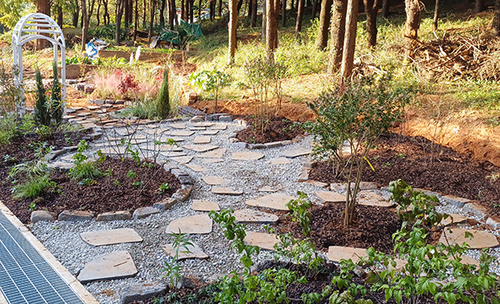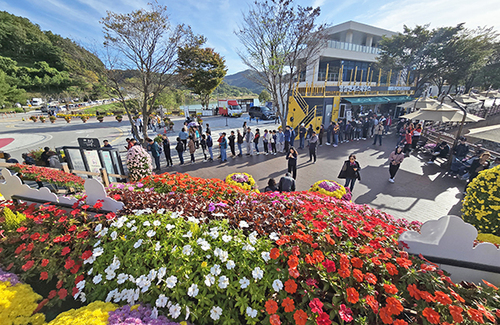| ▲ 백제시대 공예의 정수(精髓)로 알려진 익산 미륵사지 서탑에서 발견된 '사리장엄구'가 출토 14년 만에 국보로 지정됐다. (왼쪽 = 금동사리외호ㆍ오른쪽 = 금제 사리내호) / 사진제공 국립익산박물관 © 김현종 기자 |
|
백제시대 공예의 정수(精髓)로 알려진 익산 미륵사지 서탑에서 발견된 '사리장엄구'가 출토 14년 만에 국보로 지정됐다.
전북 익산시는 "27일자로 사리를 불탑에 안치할 때 사용하는 용기나 함께 봉안되는 모든 공양물(供養物)인 '사리장엄구'가 국가지정문화재로 지정돼 다시 한 번 백제역사 문화도시로서 위상을 드높이게 됐다"고 밝혔다.
이번에 지정된 국보는 639년(백제 무왕 40년) 절대연대를 기록한 금제 사리봉영기(金製 舍利奉迎記)와 함께 금동사리외호(金銅舍利外壺) 및 금제 사리내호(金製 舍利內壺), 각종 구슬과 공양품을 담았던 청동합(靑銅合) 6점을 포함해 총 9점으로 구성돼 있다.
'사리장엄구'는 지난 2009년 미륵사지 석탑 보수정비사업 과정에 발견됐으며 장기간의 보존처리와 학술조사를 거쳐 2018년 보물로 지정됐으며 현재 국립익산박물관 대표유물로 전시되고 있다.
익산 미륵사지 서탑에서 발견된 '사리장엄구'는 2009년 1월 14일 심주석(心柱石 = 탑 구조의 중심을 이루는 기둥)의 사리공(舍利孔 = 불탑 안에 사리를 넣을 크기로 뚫은 구멍)에서 나온 9,900여점의 유물이다.
금제 사리봉영기에는 백제 왕후(좌평 =佐平ㆍ사택적덕 =沙宅積德)의 딸)가 재물을 시주해 가람을 세우고 기해년(己亥年 = 639)에 사리를 봉안해 왕실의 안녕을 기원한다는 내용이 기록돼 있다.
'삼국유사(三國遺事)' 무왕조에 전하는 미륵사 창건설화를 구체화해 미륵사지 석탑의 조성 연대와 주체에 대한 역사적 사실이 밝혀져 사리장엄구 가운데 가장 주목되는 유물이다.
사리 내ㆍ외호는 그릇 표면의 연판문과 당초문 등이 생동감 넘치게 표현됐으며 몸체의 허리 부분을 돌려 여닫는 독창적인 구조로 기형(器形)의 안정성과 함께 세련된 멋이 한껏 돋보인다.
특히 6점의 청동합 중 하나에 '상부달솔목근(上卩達率目近)'이라는 명문이 새겨져 있어 시주자의 신분과 공양품의 품목까지 알 수 있어 사료적 가치 크다.
또 각종 공양물 넣어 봉안된 청동합들은 우리나라 유기(鍮器) 제작 역사의 기원을 밝혀 줄 중요한 자료로 평가되고 있다.
'사리장엄구'는 백제 왕실에서 발원해 제작한 것으로 석탑 사리공에서 639년(백제 무왕 40년) 봉안 당시 모습 그대로 발견돼 고대 동아시아 사리장엄 연구에 있어 절대적 기준이 된다는데 의의가 담겼다.
당대 최고급 재료와 최고의 기술력이 응집돼 탁월한 예술품으로 승화돼 한국공예사에 뚜렷한 자취를 남긴 유물로 그 위상이 높다.
또한 7세기 전반 백제 금속공예 기술을 증명해주는 등 동아시아 사리공예품의 대외교류를 밝혀 주는 자료로 역사ㆍ학술ㆍ예술적 가치가 매우 커 국보로 지정돼 영구히 보존돼야 할 것으로 평가됐다.
정헌율 익산시장은 "이번 미륵사지 석탑 사리장엄구 국보 승격으로 백제왕도 익산의 위상이 재조명돼 감격스럽다"며 "문화재청ㆍ국립익산박물관과 보존에 힘을 모아 후대에 잘 전하겠다"고 말했다.
☞ 아래는 위 기사를 구글 번역이 번역한 영문 기사의 '전문' 입니다.
구글 번역은 이해도를 높이기 위해 노력하고 있으며 영문 번역에 오류가 있음을 전제로 합니다.
【Below is the 'full text' of the English article translated by Google Translate.
Google Translate is working hard to improve understanding, and assumes that there are errors in the English translation.】
Iksan Mireuksaji West Pagoda 'Reliquary Reliquary' Designated as a National Treasure
The essence of craft in the Baekje era… Reaffirming Iksan's status as a World Heritage City
Reporter Kim Ga-young
Known as the essence of craftsmanship in the Baekje era, the 'sarira reliquary' found in the west pagoda of Mireuksa Temple Site in Iksan has been designated as a national treasure 14 years after its excavation.
Iksan, Jeollabuk-do, said, "On the 27th, 'Sari Jangeomgu', which is a container used when enshrining sarira in a stupa and all offerings enshrined together, was designated as a national cultural property, raising its status as a cultural city of Baekje history once again. This has happened," he said.
The national treasures designated this time include the gold Sari Bonyeonggi (金製 舍利奉迎記) with an absolute age of 639 (the 40th year of King Mu of Baekje), as well as the gilt-bronze Sari Outer Box and the Gold Sarinee Lake (金製 舍利奉迎記). It consists of a total of 9 pieces, including 6 pieces of bronze that contained various beads and offerings.
The 'Sarijangeomgu' was discovered in the course of a stone pagoda maintenance project at Mireuksa Temple Site in 2009, and was designated as a treasure in 2018 after long-term preservation and academic research.
The 'Sarijangeomgu' discovered in the West Pagoda of Mireuksa Temple Site, Iksan, was discovered on January 14, 2009 from a sarira ball (舍利孔 = a hole drilled to fit a sarira inside the stupa) of Shim Ju-seok (心柱石 = pillar that forms the center of the pagoda structure) with a total of 9,900 pieces. It is a relic of a woman's shop.
In the Geumje Sari Bonggi period, the Baekje queen (Jwapyeong = 佐平·Sataek Jeokdeok = 沙宅積德)'s daughter donated wealth to build a garam, and in the year of Gihae (己亥年 = 639), the sarira was enshrined to pray for the peace of the royal family. It is recorded.
It is the most noteworthy relic among the sarira relics as the historical facts about the construction date and subject of the stone pagoda of Mireuksa Temple were revealed by materializing the construction story of Mireuksa Temple handed down to the Mu Dynasty of 'Memorabilia of the Three Kingdoms'.
In the inner and outer shells of the sari, the lotus plate pattern and arabesque patterns on the surface of the bowl are expressed in a lively way, and the unique structure of opening and closing by turning the waist part of the body highlights the stability of the shape and the sophisticated style.
In particular, one of the six bronze cases has the inscription 'Sangbu Dalsol Mokgeun (上卩達率目近).
In addition, the bronze boxes enshrined with various offerings are evaluated as important data that will reveal the origin of the history of Korean pottery production.
'Sarijangeomgu' originated from the royal family of Baekje and was produced in the stone pagoda in 639 (the 40th year of King Mu of Baekje) as it was when it was enshrined.
It has a high status as a relic that has left a distinct trace in the history of Korean crafts by sublimating it into an excellent work of art with the condensation of the finest materials and the best technology of the time.
In addition, it is a material that reveals foreign exchange of East Asian sari crafts, such as proving Baekje's metal craft skills in the first half of the 7th century. It has great historical, academic, and artistic value.
Jeong Heon-yul, Mayor of Iksan, said, "I am thrilled that the status of Iksan in the Baekje Dynasty has been re-examined with the status of the stone pagoda reliquaries at Mireuksa Temple Site raised to the national treasure status."





















 많이 본 뉴스
많이 본 뉴스











